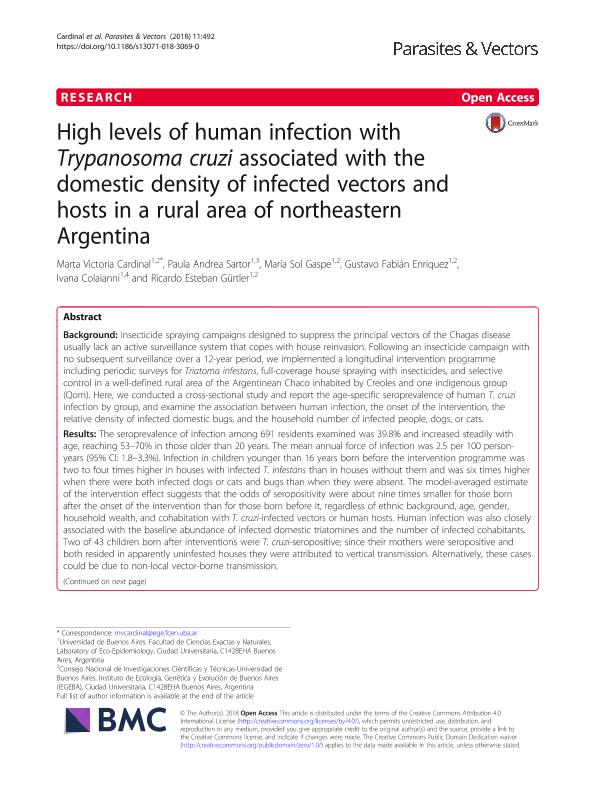Artículo
High levels of human infection with Trypanosoma cruzi associated with the domestic density of infected vectors and hosts in a rural area of northeastern Argentina
Cardinal, Marta Victoria ; Sartor, Paula Andrea
; Sartor, Paula Andrea ; Gaspe, Maria Sol
; Gaspe, Maria Sol ; Enriquez, Gustavo Fabián
; Enriquez, Gustavo Fabián ; Colaianni, Ivana; Gurtler, Ricardo Esteban
; Colaianni, Ivana; Gurtler, Ricardo Esteban
 ; Sartor, Paula Andrea
; Sartor, Paula Andrea ; Gaspe, Maria Sol
; Gaspe, Maria Sol ; Enriquez, Gustavo Fabián
; Enriquez, Gustavo Fabián ; Colaianni, Ivana; Gurtler, Ricardo Esteban
; Colaianni, Ivana; Gurtler, Ricardo Esteban
Fecha de publicación:
08/2018
Editorial:
BioMed Central
Revista:
Parasites and Vectors
ISSN:
1756-3305
Idioma:
Inglés
Tipo de recurso:
Artículo publicado
Clasificación temática:
Resumen
Background: Insecticide spraying campaigns designed to suppress the principal vectors of the Chagas disease usually lack an active surveillance system that copes with house reinvasion. Following an insecticide campaign with no subsequent surveillance over a 12-year period, we implemented a longitudinal intervention programme including periodic surveys for Triatoma infestans, full-coverage house spraying with insecticides, and selective control in a well-defined rural area of the Argentinean Chaco inhabited by Creoles and one indigenous group (Qom). Here, we conducted a cross-sectional study and report the age-specific seroprevalence of human T. cruzi infection by group, and examine the association between human infection, the onset of the intervention, the relative density of infected domestic bugs, and the household number of infected people, dogs, or cats. Results: The seroprevalence of infection among 691 residents examined was 39.8% and increased steadily with age, reaching 53-70% in those older than 20 years. The mean annual force of infection was 2.5 per 100 person-years (95% CI: 1.8-3.3%). Infection in children younger than 16 years born before the intervention programme was two to four times higher in houses with infected T. infestans than in houses without them and was six times higher when there were both infected dogs or cats and bugs than when they were absent. The model-averaged estimate of the intervention effect suggests that the odds of seropositivity were about nine times smaller for those born after the onset of the intervention than for those born before it, regardless of ethnic background, age, gender, household wealth, and cohabitation with T. cruzi-infected vectors or human hosts. Human infection was also closely associated with the baseline abundance of infected domestic triatomines and the number of infected cohabitants. Two of 43 children born after interventions were T. cruzi-seropositive; since their mothers were seropositive and both resided in apparently uninfested houses they were attributed to vertical transmission. Alternatively, these cases could be due to non-local vector-borne transmission. Conclusions: Our study reveals high levels of human infection with T. cruzi in the Argentinean Chaco, and the immediate impact of sustained vector surveillance and selective control actions on transmission.
Archivos asociados
Licencia
Identificadores
Colecciones
Articulos(IEGEBA)
Articulos de INSTITUTO DE ECOLOGIA, GENETICA Y EVOLUCION DE BS. AS
Articulos de INSTITUTO DE ECOLOGIA, GENETICA Y EVOLUCION DE BS. AS
Citación
Cardinal, Marta Victoria; Sartor, Paula Andrea; Gaspe, Maria Sol; Enriquez, Gustavo Fabián; Colaianni, Ivana; et al.; High levels of human infection with Trypanosoma cruzi associated with the domestic density of infected vectors and hosts in a rural area of northeastern Argentina; BioMed Central; Parasites and Vectors; 11; 492; 8-2018; 1-13
Compartir
Altmétricas



